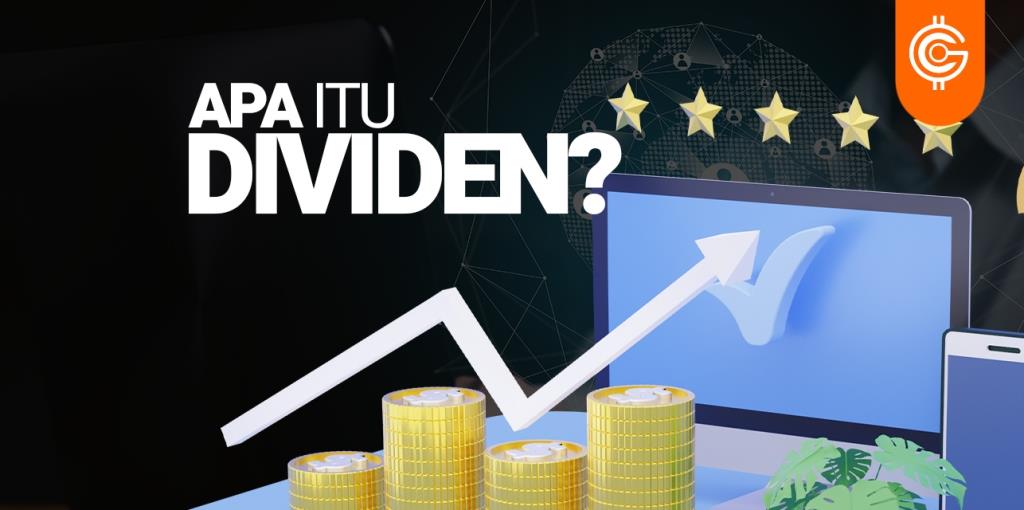What Is Dividend
In an investment, there will certainly be a return on every purchase. This form of return will be divided into two, namely Capital Gain and Dividend. One of the terms we're going to learn when it comes to investing today is dividends. Dividends are the distribution of profits to shareholders based on the shares you own. In other words, dividends are the results paid by the company to shareholders in the form of shares or cash.As an investor, of course you will expect this profit or profit when buying a stock. This dividend itself has the purpose of maintaining the company's capital level in the way mentioned earlier, namely providing benefits to its recipients because it has helped reduce the amount of tax that must be paid (stock dividends). The dividends distributed by the company to the shareholders are calculated based on the difference between the company's profit minus retained earnings. The retained earnings themselves are the profits kept by the company to finance future expansion.
Types of Dividends
After knowing what dividends are and where they come from, this time we will learn what are the types of dividends. There are also various types of dividends, depending on the form of the dividend itself. For more details, we can learn about it through the article below. However, before knowing the type, you can fill out GI's internal survey at the link.Cash Dividend
For what is the cash dividend itself, cash dividend (Cash Dividend) is the distribution of the results of work in cash, of course. This form of dividend payment is the most common and most popular payment among companies and investors. The company will pay 2 to 4 times to pay dividends within a period of one year. The amount distributed will be based on the number of shares you own. There will usually be a predetermined process for the declaration of dividends.Stock Dividend
Meanwhile, what is a stock dividend (Stock Dividend) is a dividend paid to shareholders by issuing or giving new shares to the company. The payment method in these shares is also the same as cash dividends, namely based on the number of shares you already own or the investor. This type of dividend will later be able to increase the number of outstanding shares. If payments in the form of shares are made, the company's liquidity position will not change. This is because the payment with dividends is not part of a company's cash flow.Goods Dividend
For what is a goods dividend, goods dividend is also commonly referred to as property dividend (Property Dividend) which is a type of dividend that is distributed in the form of goods, in addition to cash. However, there are several things that must be considered by companies in distributing dividends for this type of goods. The company must ensure that the goods distributed are goods that can be redivided later. Not only that, the company must also ensure that the dividend distribution carried out by the company does not interfere and has a periodic influence on the company itself.Script Dividends
Meanwhile, what is a script dividend is a dividend that can be given in the form of a script or promise of debt (Script Dividend). This dividend is like a property dividend, if the company does not have enough funds to pay dividends, then investors can choose to pay their dividends in the form of debt promissory notes in order to pay shareholders with a period that has been agreed upon by both parties, namely, the company and shareholders.You don't have to worry about how the company will pay off this script dividend because with the issuance of this script dividend, the company has acknowledged the existence of new debt, and this debt will also be recorded on their balance sheet. In addition, this type of dividend is commonly also known as interest. So the company must also pay interest until the debt has been paid to the shareholders.
Liquidation Dividend
Meanwhile, what is a liquidation dividend (Liquidating Dividend) is a dividend that returns the initial capital contributed by shareholders as the company's equity. These dividends will generally occur when the company is about to end their business or it can be said that the company is bankrupt so they provide dividends in this form of liquidation. During the bankruptcy period of a company, it is indeed an obligation for them to return the capital shares that have been given by shareholders or investors. By returning the company's share capital, the company will no longer have debts or other problems behind it. After knowing the types, also consult your trades through the Trader Assessment so that you can understand more deeply the knowledge that you don't know.
How to Calculate Dividends
For each share owned by each shareholder, it will definitely have the same value. Because of this, to find out the value per share (Dividend Per Share/DPS) can be done by dividing the total amount of dividends by the number of shares that the company has issued. Before knowing how to calculate dividends, it's a good idea to know the terms used when calculating dividends themselves.- The Dividend Payout Ratio (DPR) which is a ratio calculation is based on how much of the company's profit is divided into dividends for shareholders. For example, a company gets a net profit of 2 billion. Then the company determined to distribute dividends of 50% of the total net profit. So the total dividend distributed by the company based on the DPR is IDR 1 billion.
- Dividend Per Share (DPS) which is a calculation by the company for the value of dividends based on the total number of shares outstanding. For example, a company distributes dividends of 1 billion with 5 million shares outstanding. So the DPS received by shareholders is 1 billion divided by 5 million to IDR 200 per share.
- Meanwhile, Dividend Yield is a calculation of shares based on the price of outstanding shares. For example, a company distributes shares with a value of IDR 200 per share. The company's share price on the closing date was IDR 5,000. The dividend yield calculation is 200 divided by 5,000 and then subtracted by 100%, then the result is 4%. That way, the company's dividend yield is 4%.
Dividend Formula
For more details, you can understand the following formula and examples. DPS = Total Dividend Value / Number of Shares.Example of Dividends
The method of calculating the total amount of dividends that will be paid later, can be calculated using the formula of net profit multiplied by the Dividend Payout Ratio (Net Profit x Dividend Payout Ratio). The Dividend Payout Ratio itself is the percentage of net profit that has been deducted by taxes. Example:- Net profit = Rp 2.000.000.000
- Dividend Payout Ratio = 20%
- Number of Shares = 2.000.000
- Amount of dividends paid (all dividend value) = IDR 2,000,000,000 x 20% = IDR 400,000,000
- DPS = IDR 400,000,000 / 2,000,000 = IDR 200. So the dividend per share that must be paid is IDR 200.
- Stock Shares = 9.600
- Cash dividend distribution = Rp 65,48
- Dividends before tax = 9.600 lembar x 65,48 = Rp 628.608
- Dividends after tax = Rp 628.608 - (628.608 x 10%) = Rp 565.748.
- That way, the dividends that will be received for their ownership are Rp 565.748.

Dividend Distribution Procedure
Stock dividend distribution will refer to the distribution of a company's profits to stock investors based on the portion of shares owned. The amount of profit distributed can be found out from the company's financial performance report. At the end of each period, the company will issue a financial performance report. Either in the form of financial statements for 3 months, semesters, or years. With this report, investors and other related parties can find out how the financial performance of a company is.Including related to the amount of this dividend. Those of you who play the role of investors, it is very important to know and understand how the dividend distribution procedure of your stock investment is. There is also a mechanism for giving dividends from companies to their investors in 2 ways. The first is an interim dividend. What is an interim dividend? This interim dividend is a dividend given in the period before the company's financial books are closed or still in the current year.
Announcement Date
This announcement date (declaration date) is officially made by the issuer or company. The date of this announcement includes the payment date, the date of recording, and the amount of cash dividends per share that will be distributed.Date of Recording
This date of record belongs to the shareholder who is entitled to the distribution of the relevant dividends.Dividend Date
This dividend date is the deadline or date of stock trading activities that are included in the calculation to get dividends. Investors who happen to buy shares on the-date also have the opportunity to get dividends.Ex-Dividend Date
This date is a date that does not include the calculation of dividend distribution. If there are still investors who buy shares in this date period, then the investor will not get dividends on the said date until the investor gets the next period with the intention of waiting for the distribution of dividends in the next period. The ex-date date is determined one working day after the-date date, which means, the ex-date is the first day on which the right to share ownership has expired.
Payment Date
This payment date is the day of dividend payment by the issuer or company to investors in accordance with the records and agreements of both parties. In addition, there is also a procedure for making a dividend distribution schedule as described above, including:- Determination of the names of shareholders who are entitled to receive dividends to be distributed.
- Determining the distribution of dividends or what type of dividends will be distributed, this distribution can be through KSEI or the broker where the investor invests the funds or the place where the shares will be distributed.
- Determine the time, when the dividends can start to be distributed to investor accounts, according to the list that has been made.
- After that, do the tax calculation on the 10% dividend as described above. Please note, in the Omnimbus Law Bill, this type of tax will be abolished.
 Last:
Last: 







